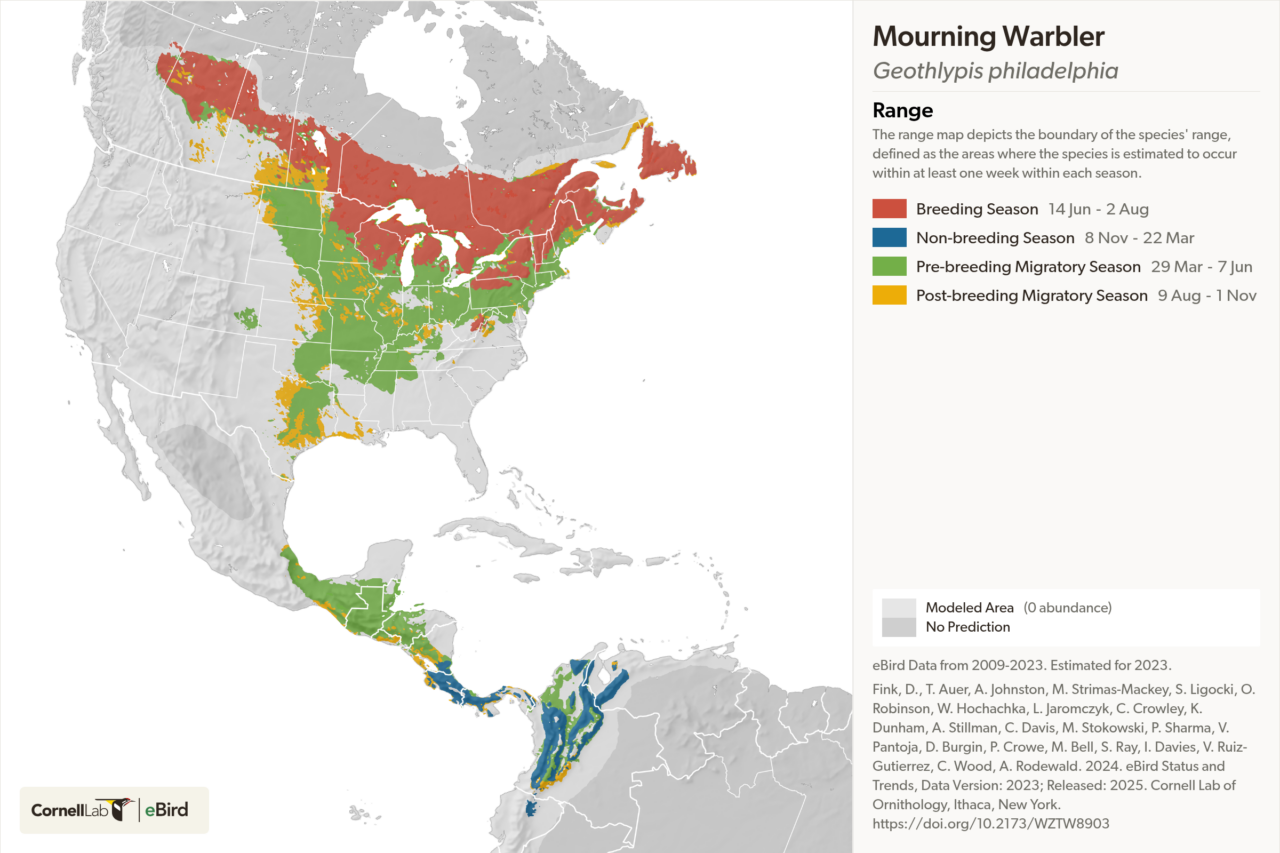Mourning Warbler (MOWA)
Geothlypis philadelphia



Range
Mourning Warblers breed throughout North America’s boreal forests. They migrate through the central U.S. and Central America to winter in Central and South America’s thick undergrowth.
Additional Maps
Identification
Mourning Warblers are small, chucky birds with small, curved brown beaks and tan legs. Breeding males have bright yellow underparts, green upperparts, a gray hood, and black chest. Breeding females look like males with faded colors and gray chests.
Juvenile Mourning Warblers have less prominent hoods and have less contrasted upper and lower parts. They are overall more brown and less vibrantly yellow than mature individuals.
Their primary song is a rapid churry churry churry churry chorry chorry with each phrase rising in pitch. The song changes depending on the population. Their main call is a loud, rich tsip.
Habitat
Mourning Warblers live in disturbed or regrowing areas of boreal forests. They choose areas with thick brush, undergrowth, and stumps where tall trees are overtaken by shorter growth. This preference means they move breeding sites regularly as 7—10 years’ worth of tree growth makes an area not preferable.
Conservation Status
- Listed as Least Concern by the International Union for Conservation of Nature (IUCN)
- Listed as Secure by NatureServe Explorer
- Listed as On Alert by NABCI’s State of the Birds 2022
- Listed as Species of Greatest Conservation Need by the 2015 Massachusetts Wildlife Action Plan
- Listed as Bird Species of Greatest Conservation Need by the 2015-2025 Maryland State Wildlife Action Plan
- Listed as Species of Greatest Conservation Need by the 2015-2025 Pennsylvania Wildlife Action Plan
Threats to Conservation
Mourning Warblers have experienced an annual decline of 1.2% between 1966 and 2015, putting them at a decline of 45% over the entire period. Mourning Warblers are particularly susceptible to striking tall structures at night. Because of their preference for young forests, Mourning Warblers actually benefit from some deforestation operations such as logging, oil drilling, and development as the early stages of these operations create the brush and small tree populated environments that they nest in. However, many of these operations use heavy machinery and pollutants that quickly make areas unusable for the Mourning Warbler and other species.
Funding Opportunities
- America the Beautiful Challenge
- Connecticut Ornithological Association (COA) Mini Grant
- Conservation Nation Grant Program
- Community Forest Program
- Delaware River Program
- Delaware River Watershed Initiative
- Environmental Quality Incentives Program (EQIP)
- Land Trust Bird Conservation Initiative Small Grant Program
- MassWildlife Habitat Management Grant Program
- Neotropical Migratory Bird Conservation Act (NMBCA) Grant
- NFWF Grants Library
- Northeast Forests and Rivers Fund
- Partners for Fish and Wildlife Grant
- Regional Conservation Partnership Program (RCPP)
- Sustainable Forestry Initiative (SFI) Conservation Grant Projects
- The Migratory Bird Program
